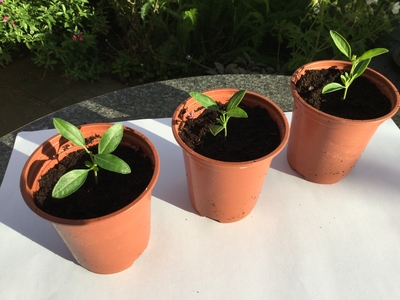Grow Your Own Lavender

Lavender is one of the ‘go-to’ plants for a cottage garden style planting scheme but it has so many uses, from culinary to wellbeing so here’s my quick guide on how to sow, grow and maintain your beautiful Lavender.
Lavendula is the botanical name and they are easy to grow too which makes them ideal for any border. They look fab with roses and other perennials and shrubs.
There are many varieties to choose from – the English lavender is the hardiest – you may see this as Lavandula angustifolia on plant labels. Another popular variety is French lavender, which has cute ‘ears’ on the top of the flower – sometimes known as butterfly lavender. All of them are loved by pollinators.
This plant is happiest in a sunny garden with well-drained, chalky or sandy soil. They don’t tolerate shade, damp or freezing cold as they originate from sunny climates, so they thrive in Mediterranean environments and are suitable for containers, herb and gravel gardens, and balconies.
Lavender come in a range of colours too – from white to pink, mauves and blues, so there is something for everyone’s colour scheme.

How to grow lavender
They can be easily grown from seed (follow seed packet instructions) but if you buy already grown plants, put them out once the soil has started to warm up, usually from April onwards. If you plant lavender in the winter it’s more likely the plants will be vulnerable to rotting due to cold and wet soils.
You can also grow in containers – use a multipurpose compost or John Innes No2, add in some grit to improve drainage. Keep watered until established but especially during hot and dry periods as containers dry out quickly.

Propagation / cuttings
Another way to grow lavender is by taking cuttings. If you’ve not done this before, it’s a simple process and can be applied to many perennials and deciduous shrubs. Who doesn’t love a free plant?
In horticultural terms it’s called Softwood Cuttings (just in case you want to research it further). Its called softwood as you are cutting the new growth from the plant in early spring when the tips are young and flexible.
Step 1
Collect material (shoots) early in the day when the plant is full of water (turgid) and healthy. Use non-flowering shoots, as they will root more readily. Remove up to 10cm of shoot, cutting off the material neatly above a bud on the parent plant.
Step 2
Most softwood cuttings are nodal – this is just below the leaf joint. This is where there’s a concentration of hormones to stimulate root production.
- Using a sharp knife (or scissors) trim below a node to make a cutting about 5-10cm long
- Remove the lower leaves, pinch out the soft tip and dip the base of the cutting in hormone rooting powder (which is available from any garden retailers)
- In a pot of compost using a dibber (a clean blunt stick), make a hole and insert the base of the cutting with the first pair of leaves just above the level of the compost. Press gently around it to ensure the compost is firm (but not solid).
- Label the pot and water it from above to settle the compost
- Cuttings should be placed in good light but not direct, scorching sunlight.
- Ensure the compost is moist until the cuttings are well-rooted which takes about 6 to 10 weeks
- Possibly not all cuttings will root, so remove any dead, rotting, dying or diseased material so it doesn’t infect the other cuttings.
These are Salvia cuttings, but it’s the same process.


Maintenance
Some care and attention is required to keep it healthy and happy. Here are some things you need to know about maintaining lavender:
Pruning
To stop your plants getting woody and mis-shapen it’s best to prune back in the late summer once all the flowers have stopped. This can be done using shears or secateurs. Cut back all the spent flowers and trim back this year’s growth, leaving around 2-3cm. Don’t cut back to the woody stems as the plant won’t be able to grow the following year. It’s likely you will need to replace the plant in this case. You can always tidy up the plant in the spring.
Watering
It prefers to be watered moderately and infrequently, about once a week or when the top inch of the soil feels dry. Lavender is a drought-tolerant plant that doesn’t like wet or soggy soil. You can use a watering can with a fine nozzle to water from below, or a spray bottle to mist the soil gently. Avoid overwatering or underwatering your lavender, as both can cause root rot or wilting.
Soil
Plant your Lavender in well-drained soil that does not retain too much moisture or become compacted. If your soil is heavy or clay-like, you can mix in some sand or grit to improve drainage.
Sunlight
Lavender loves full sun and needs at least 6 hours of bright direct sunlight per day. If you grow it indoors, you need to place it in a sunny windowsill, or a conservatory. If you grow it outdoors, you need to choose a spot that is not shaded by trees or buildings. Lavender can tolerate some shade, but it will produce fewer flowers and more foliage.

Feeding
As Lavender prefers poor soil it’s best not to use chemical fertilisers, as they can cause excessive leaf growth and reduce flower production.
Pests and Diseases
Lavender is generally resistant to most pests and diseases, but it can still be affected by some common problems such as Rosemary beetle. Also be mindful of buying home-grown lavender rather than imported, as Xylella (a bacterial disease) is being spread by imported plants and thankfully it has been kept out of the UK so far. If you want to know more about Xylella click this link to the RHS website – https://www.rhs.org.uk/disease/xylella-fastidiosa
Rosemary beetle
is a leaf beetle (family Chrysomelidae), there are about 250 species of leaf beetle found in Britain. They all feed on plants. Rosemary beetle eats the foliage and flowers of various aromatic plants, such as rosemary, lavender, sage, thyme and some other related plants. In most circumstances the beetle can be accepted as part of the biodiversity a healthy garden supports as it does not eat enough to harm healthy plants. If they do bother you/the plant, simply pull them off by hand and dispose of them – there’s no need for a chemical intervention.

Drying lavender
It’s easy to dry and preserve so that the seeds can be used in scented sachets or added to sugar for culinary purposes.
Simply harvest the lavender stems before it’s fully in bloom (this retains the scent and colour). Gather the stems into a bunch (approx. 2cm in diameter). Wrap a rubber band around the stem ends to hold in place and hang the bunch upside down in a cool dry and dark place for 2-4 weeks.
You can also use this process for drying other flowers and herbs.

Available online from the Border in a Box gardening gift shop:
Gift box includes: Lavender seeds, handmade lavender drawer sachet (designs and colours vary) and an A6 lined notebook and handmade soap. Makes a gorgeous letterbox gift for birthdays and ‘thinking of you’. For more information, click the link below.
https://borderinabox.com/product/grow-your-own-lavender-gift-box/

 Free Delivery
Free Delivery Upgrade to 24 Hour Tracked Delivery
Upgrade to 24 Hour Tracked Delivery

